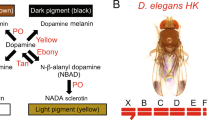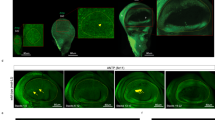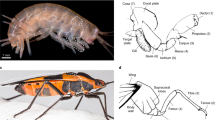Abstract
Insects are thought to have evolved from millipede-like ancestors composed largely of a series of identical, leg-bearing segments. This view of insect evolution is supported by the existence of homoeotic mutations which transform particular abdominal and head segments into thoracic segments1–3. Such transformations are described as atavistic3, because they return specialized segments to a more primitive condition. In Drosophila, several dominant mutations of the homoeotic locus Antennapedia (Antp) lead to a transformation of the antenna to the second leg4–8. Here, I describe the isolation and characterization of apparent null alleles of the Antp locus. These mutations lead to a homoeotic phenotype which is the reverse of the dominant Antennapedia phenotype, namely, they result in the transformation of the second leg into an antenna but do not alter the development of the normal antenna itself. This result indicates that (1) the product of the wild-type Antp gene is normally active in the mesothorax where it promotes a mesothoracic pathway of development instead of an antennal pathway, (2) the Antp+ gene product is normally absent or inactive in the antenna, and (3) dominant mutations of the locus result in the inappropriate activity of the wild-type gene product in the antenna, and hence in the transformation of antenna to leg. Thus, unlike most other homoeotic gene products, the product of the Antp+ gene seems to promote, not to repress or modify, an atavistic condition.
This is a preview of subscription content, access via your institution
Access options
Subscribe to this journal
Receive 51 print issues and online access
$199.00 per year
only $3.90 per issue
Buy this article
- Purchase on Springer Link
- Instant access to full article PDF
Prices may be subject to local taxes which are calculated during checkout
Similar content being viewed by others
References
Lewis, E. B. Am. Zool. 3, 33–56 (1963); Nature 276, 565–570 (1978).
Tazima, Y. The Genetics of the Silkworm (Logos, London, 1964).
Garcia-Bellido, A. Am. Zool. 17, 613–629 (1977).
Yu, S. thesis, California Inst. Technol. (1949).
Le Calvez, J. Bull. Biol. Fr. Belg. 82, 97–113 (1948).
Lewis, E. B. Drosoph. Inf. Serv. 30, 76–77 (1956).
Gehring, W. Arch. Klaus-Stift. Vererb.-Forsch. 41, 44–54 (1966).
Kaufman, T. C., Lewis, R. & Wakimoto, B. Genetics 94, 115–133 (1980).
Lifschytz, E. & Falk, R. Genetics 62, 353–358 (1969).
Denell, R. E. Mutat. Res. 15, 221–223 (1972).
Duncan, I. W. & Kaufman, T. C. Genetics 80, 733–752 (1975).
Lewis, E. B. & Bacher, F. Drosoph. Inf. Serv. 43, 193 (1968).
O'Brian, S. J. & MacIntyre, R. J. in Genetics and Biology of Drosophila Vol. 2 (eds Ashburner, M. & Wright, T. R. F.) 395–551 (Academic, London, 1978).
Wakimoto, B. T. & Kaufman, T. C. Devl Biol. 81, 51–64 (1981).
Lindsley, D. L. & Grell, E. L. Carnegie Inst. Wash. Publ. 627 (1968).
Ferrus, A. Genetics 79, 589–599 (1975).
Morata, G. & Ripoll, P. Devl Biol. 42, 211–221 (1975).
Garcia-Bellido, A., Ripoll, P. & Morata, G. Nature new Biol. 245, 251–253 (1973); Devl Biol. 48, 132–147 (1976).
Crick, F. H. C. & Lawrence, P. A. Science 189, 340–347 (1975).
Morata, G. & Lawrence, P. A. Nature 274, 473–474 (1978); Devl Biol. 70, 355–371 (1979).
Lawrence, P. A., Struhl, G. & Morata, G. J. Embryol. exp. Morph. 51, 195–208 (1979).
Kauffman, S. A. & Ling, E. Wilhelm Roux Arch. EntwMech. Org. 189, 147–153 (1980).
Ferris, G. F. in Biology of Drosophila (ed. Demerec, M.) 369–419 (Wiley, New York, 1950).
Author information
Authors and Affiliations
Rights and permissions
About this article
Cite this article
Struhl, G. A homoeotic mutation transforming leg to antenna in Drosophila. Nature 292, 635–638 (1981). https://doi.org/10.1038/292635a0
Received:
Accepted:
Issue Date:
DOI: https://doi.org/10.1038/292635a0
This article is cited by
-
Transcriptome analysis of different life-history stages and screening of male-biased genes in Daphnia sinensis
BMC Genomics (2022)
-
Hox dosage contributes to flight appendage morphology in Drosophila
Nature Communications (2021)
-
Genomic resources and toolkits for developmental study of whip spiders (Amblypygi) provide insights into arachnid genome evolution and antenniform leg patterning
EvoDevo (2020)
-
Using genetics to understand biology
Heredity (2019)
-
The pivotal role of aristaless in development and evolution of diverse antennal morphologies in moths and butterflies
BMC Evolutionary Biology (2018)
Comments
By submitting a comment you agree to abide by our Terms and Community Guidelines. If you find something abusive or that does not comply with our terms or guidelines please flag it as inappropriate.



